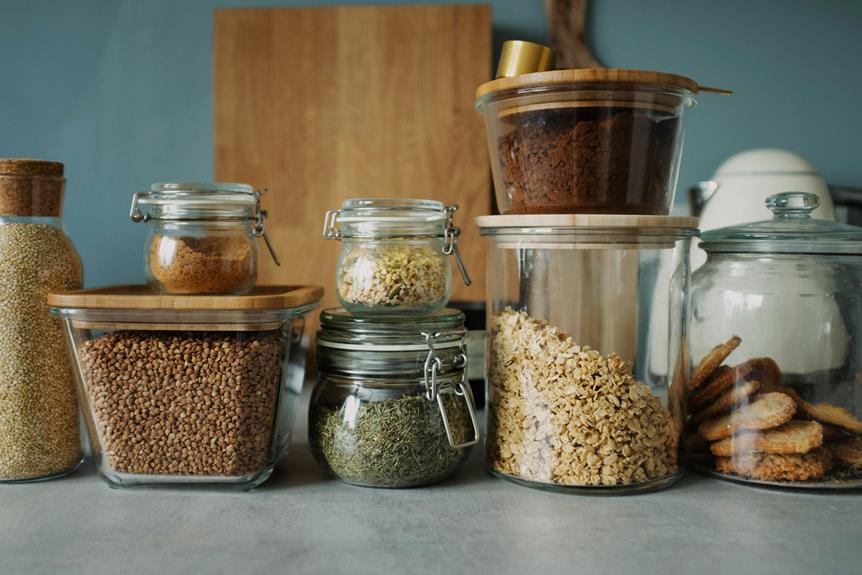Most people aren't aware that the way you store herbs from your AeroGarden can greatly impact their flavor and shelf life. You've put in the effort to grow these herbs, and with a few careful steps, you can guarantee they remain fresh and potent for much longer. Whether you choose to dry, freeze, or immerse them in oil, each method has its nuances that can either preserve or compromise the essential oils that give herbs their unique aromas and tastes. So, what's the best method to keep those flavors intact in your kitchen? Let's explore your options and find out how you can maximize the benefits from your indoor garden.
Key Takeaways
- Wash and gently pat dry Aerogarden herbs before storing.
- Freeze chopped herbs on a tray before transferring to airtight bags.
- Dry herbs using air, dehydrator, or oven methods to preserve flavor.
- Store dried herbs in a cool, dark place in airtight containers.
- Infuse oils with herbs and keep in a sealed jar in a dark location.
Harvesting Your AeroGarden Herbs
To harvest your AeroGarden herbs, simply snip the leaves or stems as needed, ensuring not to remove more than a third of the plant at one time. This method allows you to manage the growth and health of your herbs effectively, ensuring they continue to flourish. You'll want to use sharp scissors or pruning shears to make clean cuts. This precision helps prevent damage to the remaining parts of the plant, which can hinder its future growth.
Choose the oldest leaves first, as they're the most mature and have the most flavor. This selective approach not only maximizes the culinary quality of your herbs but also stimulates new growth, keeping your plants productive.
It's vital to monitor the progress and condition of your herbs, adjusting your harvesting technique as needed to cater to each plant's specific needs.
Washing and Preparing Herbs
After harvesting your AeroGarden herbs, gently wash them under cool running water to remove any dirt or debris. It's important to handle the leaves and stems carefully to preserve their delicate structures and potent flavors. Once rinsed, shake off the excess water. This step is essential as it minimizes moisture, which can lead to spoilage during storage.
Next, sort your herbs. Discard any damaged or discolored leaves. You're in control here, selecting only the best for storage. This not only guarantees quality and longevity but also maximizes the flavor of your dishes when you use them later.
Now, lay out the clean herbs on a clean cloth or paper towel. Pat them dry gently. You want to eliminate as much surface moisture as possible without damaging the leaves. This careful drying prepares your herbs for the next step in their storage journey, ensuring they stay fresh and flavorful.
Drying Methods for Herbs
Several effective methods exist for drying your AeroGarden herbs, each suited to different needs and preferences. The choice you make should fit your schedule and the specific qualities you want to preserve in your herbs.
One popular method is air drying. Simply gather your herbs into small bundles and tie them loosely. Hang these bundles in a warm, dry place with good air circulation. This method is ideal if you're not in a hurry and prefer a more natural drying process. It generally preserves flavor well, but it can take several days to a few weeks depending on the humidity and air flow.
If you're short on time, you might prefer using a food dehydrator. Set your dehydrator to the lowest setting, typically between 95°F to 115°F, and spread your herbs out in a single layer on the trays. This method can dry herbs in hours instead of days and allows you to precisely control the temperature, reducing the risk of overheating and losing flavor.
Lastly, oven drying is an option if you don't have a dehydrator. Set your oven to the lowest possible temperature, leave the door slightly open to allow moisture to escape, and check frequently. This method works quickly but requires your constant attention to prevent burning.
Freezing Techniques for Herbs
Freezing offers an excellent way to preserve the freshness and flavor of your AeroGarden herbs for months. You'll be in complete control of your herbs' longevity, ensuring they remain vibrant and potent.
To start, wash your herbs gently under cold water and pat them dry with a paper towel. This step is important to remove any dirt or impurities that could affect the flavor and longevity of your herbs once frozen.
Next, chopping your herbs finely allows you to measure them easily for future use. You can either freeze the chopped herbs directly on a baking sheet or pack them into ice cube trays. If using trays, fill each compartment about three-quarters full with herbs, then cover them with water. This method prevents freezer burn and retains the herbs' essential oils, leading to more flavorful dishes when you use them later.
Once the herbs are frozen, transfer the cubes or free-flowing pieces into airtight freezer bags. Label each bag with the date and type of herb. This organization tactic lets you quickly find and use the herbs as needed, maximizing your kitchen efficiency.
Storing Herbs in Oil
Storing your AeroGarden herbs in oil is another effective method to preserve their freshness and enhance their flavors. This technique not only extends the shelf life of your herbs but also infuses the oils with aromatic flavors perfect for cooking. You'll need to choose a high-quality oil such as olive or avocado as your base. Here's how you can master this method:
- Wash and thoroughly dry your herbs.
- Chop them coarsely or leave them whole, depending on your preference.
- Place the herbs in a clean, dry jar, then pour oil over them until they're completely submerged.
- Seal the jar tightly and store it in a cool, dark place.
To help you visualize, here's what you might use:
| Herb | Oil Type | Use Case |
|---|---|---|
| Basil | Olive Oil | Pasta sauces, dressings |
| Rosemary | Avocado Oil | Roasted meats, potatoes |
| Thyme | Olive Oil | Soups, stews |
| Mint | Avocado Oil | Desserts, Middle Eastern dishes |
Tips for Long-Term Storage
After mastering the art of storing your herbs in oil, let's explore some key strategies for guaranteeing their longevity.
Vacuum sealing stands out as a powerful method to preserve the freshness of your herbs. By removing air from the packaging, you're minimizing oxidation and extending the shelf life greatly. Invest in a good vacuum sealer and make sure you're sealing your herbs soon after harvesting to lock in their flavors and nutrients.
Freezing is another excellent option, especially for preserving the vibrant color and aroma of your herbs. Lay them out on a baking sheet to freeze individually, and then transfer them into airtight bags. This method prevents the herbs from clumping together, allowing you to use precise amounts without thawing the entire batch.
For those who prefer drying, make sure you're doing it right to maintain control over quality. Use a dehydrator or air-dry your herbs in a cool, dark place. Once fully dried, store them in tightly sealed containers away from light and heat.




Konnichiwa! (Hello!) I'm Pat Tokuyama, a Japanese tofu cookbook author, who travels for music, food, and adventure. If you like Japanese tea, checkout some of the newestorganic japanese tea, matcha bowls and noren and more!
** Curious about the Plant Based Japanese Cooking Club? ** Learn more here!